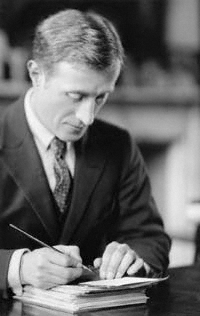John Beazley (1885-1970) was perhaps the most important contributing force to the study and classification of Greek art. Born in Glasgow, Scotland, Beazley attended Balliol College at Oxford, where he was awarded numerous prizes and distinctions. In 1907, he spent a year at the British School in Athens under the direction of Richard McGillivray Dawkins, returning to Oxford the next year to become an instructor of classics at Christ Church, Oxford. In 1925, he became the Lincoln professor of classical archaeology at Oxford and began to devote more and more time to studying Greek artwork. His particular passion was for Attic vases (those crafted around the area of ancient Athens, although most of the vases Beazley studied were found in Etruscan graves in Italy), and it is no real exaggeration to say that Beazley’s work transformed the field of art history.
To Beazley, the key to understanding and truly categorizing Greek vases was in attention to detail. Beazley’s trade was Morellian connoisseurship, in particular abductive reasoning, a method similar to the one used by medical doctors that focused on recognizing particular traits and then using them to narrow down possible explanations—in Beazley’s case, the identity of a specific painter. He focused on small details that helped him distinguish the hand of one painter to that of another—a painter’s specific style, or, as he called it “a peculiar system of renderings through which a certain conception of the human form found expression” (Whitley 37). Beazley looked for the almost unconsciously visual signature of a specific artist: in particular the composition of eyes, noses, ears, hands and feet, subtle points that only the most learned (as indeed Beazley was) could identify.
Interestingly enough, it is quite true to say that Beazley’s impact extended beyond the field of art history. At around the same time that Beazley was working (in the late nineteenth century), the field of graphology and detective fiction were just beginning to appear. It is easy to see a bit of Sherlock Holmes in John Beazley: a master who used minutiae to unlock the mysteries of the past.

Sources:
Robertson, Martin. “Beazley, Sir John Davidson (1885–1970)”, rev. Gill, David. Oxford Dictionary of National Biography. Oxford University Press. 2004. 29 Nov. 2007. <http://www.oxforddnb.com/view/article/30664>.
Whitley, James. The Archaeology of Ancient Greece. Cambridge: Cambridge Univeristy Press, 2007.
Posted at Dec 11/2007 10:11PM:
keffie: Well written summary of Beazley's life and work. What about the problems with his approach?
